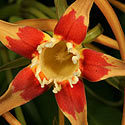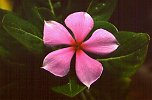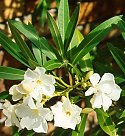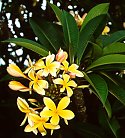|
Family:
Apocynaceae (Oleander, Frangipani, Periwinkle, Milkweed and asclepiad family)
[= Asclepiadaceae]
Life
> eukaryotes >
Archaeoplastida >
Chloroplastida
>
Charophyta > Streptophytina > Plantae (land plants)
> Tracheophyta (vascular plants) > Euphyllophyta > Lignophyta (woody plants)
> Spermatophyta (seed plants) > Angiospermae (flowering
plants)
> Eudicotyledons > Core Eudicots > Asterids > Euasterid I >
Order: Gentianales
About 415 genera and 4555 species, native mainly to tropical and warm temperate
regions, with 104 genera and 764 species native to southern Africa, an additional
five genera and six species naturalised, and an additional 19 genera and 56 species
that are cultivated in the region.
The family Asclepiadaceae has been included within the
Apocynaceae where it has been relegated to the subfamily Asclepiadoideae. The
asclepiads are treated separately here because they are such a distinctive group.
For Asclepiadoideae (asclepiads), see here.
Genera native to southern Africa (excluding Asclepiadoideae)
Information mainly from Victor et al. (2000) and
Plants
of Southern Africa - an Online Checklist (SANBI).
Acokanthera
Five
species, native from the Cape up through East Africa and across to the
southern Arabian Peninsula. Four species are native to southern Africa. |
|
Adenium
Five species, native to Africa, the Arabian Peninsula and Socotra, with four
species native to southern Africa. |
|
Alafia
About 26 species, native to tropical Africa and Madagascar,
with four species native to southern Africa (Zimbabwe and Mozambique). |
|
Ancylobotrys
Ten species, native to Africa and Madagascar, with two species native to southern Africa. |
|
Baissea
Eighteen species, native to Africa, with one species, Baissea
wulfhorstii, native to southern Africa. |
|
Callichilia
Seven species, native to Africa, with one species, Callichilia orientalis,
native to southern Africa. |
|
Carissa
About
20 species, native to Africa, Madagascar, the Mascarenes, Asia and
Australia, with five species native to southern Africa. |
|
Chlorocyathus
Two species native to southern Africa - Chlorocyathus lobulata and
Chlorocyathus monteiroea |
|
Cryptolepis
About 25 species, native to Africa, Madagascar and Asia, with
eight species
native to southern Africa. |
|
Dictyophleba
Five species, native to tropical Africa, of which one Dictyophleba lucida
is native to southern Africa (Zimbabwe and Mozambique). See
Flora of Zimbabwe. |
|
Diplorhynchus
One
species: Diplorhynchus condylocarpon (Horn-pod tree), native to tropical Africa,
with the distribution extending down into southern Africa. See
Flora of Zimbabwe. |
|
Ectadium
Three species, endemic to the Namib Desert (Namibia), on arid coastal
plains with fog. |
|
Funtumia
Two species, occurring in tropical Africa, of which one Funtumia africana
is native to southern Africa (Zimbabwe and Mozambique). See
Flora of Zimbabwe. |
|
Gonioma
One
species: Gonioma kamassi, native to forests from the Western
Cape through to Swaziland. |
|
|
Holarrhena
Four species, native to Africa and Asia, with one species, Holarrhena
pubescens (Fever pod), native to southern Africa. See
Flora of Zimbabwe. |
|
|
Hunteria
Ten species, all native to tropical Africa, of which one Hunteria
zeylanica occurs in southern Africa (specifically Mozambique). |
|
Landolphia
About
55 species, native to Africa and the Mascarene Islands, with two species,
Landolphia buchananii (recorded from Zimbabwe, see
Flora of Zimbabwe) and
Landolphia kirkii (see
Flora of Zimbabwe), native to southern Africa. Two other native species
previously placed in Landolphia now fall under
Ancylobotrys. |
|
Mascarenhasia
Twelve species in Madagascar, with one extending into Africa -
Mascarenhasia arborescens. It occurs in southern Africa, in Zimbabwe and
Mozambique; see
Flora of Zimbabwe. |
|
Mondia
Two species of liana, native to tropical Africa, one of which, Mondia whitei
(see
Flora of Zimbabwe),
occurs in the tree canopy of riverine and swamp forest in KwaZulu-Natal,
South Africa. |
|
Oncinotis
Seven species, native to Africa and Madagascar, one of which,
Oncinotis tenuiloba (= Oncinotis inandensis) (see
Flora of Zimbabwe), occurs in KwaZulu-Natal and the Eastern Cape, South Africa. |
|
Pachypodium
Of the 18 species, 13 are native to Madagascar and five are native to arid
regions of southern Africa. Two species from Madagascar are cultivated in
the region. |
|
Petopentia
One species: Petopentia natalensis, endemic to subtropical regions of
KwaZulu-Natal and the Eastern Cape. |
|
Periploca
One species native to southern Africa: Periploca nigrescens (recorded
from Zimbabwe). |
|
Pleiocarpa
Three species, distributed in tropical Africa, of which one species is native to southern Africa:
Pleiocarpa pycnantha (recorded
from Zimbabwe). See
Flora of Zimbabwe. |
|
Pleioceras
Five species, occurring in tropical Africa, of which one species is native to southern Africa:
Pleioceras orientale (recorded
from Mozambique). See
Flora of Zimbabwe. |
|
Raphionacme
About 39 species, native to Africa and the Arabian Peninsula, with 22
species native to southern Africa. |
|
Rauvolfia
About
60 species, pantropical, with two species, Rauvolfia caffra [= R.
natalensis] (Quinine tree, see
Flora of Zimbabwe) and Rauvolfia mombasiana (recorded from
Mozambique, see
Flora of Mozambique), native to southern Africa. |
|
Saba
Three species, all native to tropical Africa, of which one Saba
comorensis is native to southern Africa (Zimbabwe and Mozambique). See
Flora of Zimbabwe. |
|
Stomatostemma
Two species, native to Africa, one of which, Stomatostemma monteiroae, occurs in southern Africa. |
|
Strophanthus
About
38 species, native to Asia, Africa and Madagascar, with eight species
native to
southern Africa (including Zimbabwe) and a further three species are
cultivated in the region. |
 |
Tabernaemontana
About
110 species, occurring through the tropics, with three species native to southern Africa
and a further two species that are cultivated in the region. |
|
Tacazzea
Four species, native to Africa and Asia, one of which, Tacazzea
apiculata, is native to southern Africa. See
Flora of Zimbabwe. |
|
Voacanga
The
12 species are native to the Old World, with two species, Voacanga
africana (recorded from Zimbabwe and Mozambique, see
Flora of Zimbabwe) and Voacanga
thouarsii [= Voacanga dregei] (Wild frangipani, see
Flora of Zimbabwe), native to southern Africa
(KwaZulu-Natal and Eastern Cape). |
|
Wrightia
About 23 species, native to the Old World, with one species, Wrightia
natalensis, native to southern Africa. See
Flora of Zimbabwe. |
|
Genera naturalised in southern Africa (excluding Asclepiadoideae)
Information mainly from Victor et al. (2000) and
Plants
of Southern Africa - an Online Checklist (SANBI).
Catharanthus
(Madagascar Periwinkle genus) One of the 8 species is native to India
and Sri Lanka; the remaining 7 species are endemic to Madagascar. Catharanthus
roseus (Madagascar Periwinkle) is cultivated in southern African
gardens, but has also become a weed in warm, dry places (mainly in eastern
parts of southern Africa). |

|
Nerium (oleander
genus) The single species,
Nerium oleander
(Oleander), native to the eastern Mediterranean, is widely grown as a garden
and roadside plant in southern Africa and has also become naturalised,
especially along rocky, dry watercourses in semi-arid regions. |
 |
|
Vinca (periwinkles)
Vinca major (Greater periwinkle) (native from the
Azores to Italy) is naturalised in southern Africa. |
 |
Other genera, cultivated in southern Africa (excluding Asclepiadoideae)
List from Glen (2002).
|
Allamanda
About 14 species, native to tropical America. Three
species are cultivated in southern Africa. |
|
|
Alstonia
Two species cultivated: Alstonia macrophylla
(native to Malaysia) and Alstonia venenata (native to India). |
|
|
Beaumontia grandiflora
Native from India to Vietnam. |
|
|
Cerbera venenifera (Tanghin)
Native to Madagascar. |
|
|
Chonemorpha fragrans
Native from India to Malaysia. |
|
|
Kopsia fruticosa
Native to Malaysia and Indonesia. |
|
|
Mandevilla
Two species and one hybrid cultivated, Mandevilla laxa
(Chilean jasmine), Mandevilla splendens (native to Brazil) and
Mandevilla x amabilis. |
|
|
Ochrosia
Two species cultivated: Ochrosia elliptica
(Pokosola) (native from Australia to New Caledonia) and Ochrosia
sandwicensis (native to Hawaii). |
|
|
Plumeria (Frangipani)
Seven to eight species, native to tropical and subtropical America.
Three species are cultivated in southern African gardens: |
 |
|
Saba comorensis
Native from tropical Africa to Madagascar. |
|
|
Stemmadenia litoralis (White-bell tree)
[= Stemmadenia bella, Stemmadenia galeottiana]
Native from Mexico to Guatemala. |
|
|
Thevetia
Two species have been cultivated: Thevetia peruviana
(Yellow oleander) (native from Mexico to Peru) and Thevetia
thevetioides (native to Mexico). Thevetia peruviana is a
declared Category 1 invasive plant in South Africa so cultivation is no
longer permitted. |
|
|
Trachelospermum jasminoides (Ke-teika-kazura)
Native to Japan, Korea and China. |
|
|
Vallaris solanacea (Dudh kal)
Native from India to China. |
|
Publications
-
Glen, H.F. 2002. Cultivated Plants of Southern Africa.
Jacana, Johannesburg.
-
Victor, J.E., Bredenkamp, C.L., Venter,
H.J.T., Bruyns, P.V. & Nicholas, A. 2000. Apocynaceae. In: Seed Plants of
Southern Africa (ed. O.A. Leistner). Strelitzia 10: 71-98..
National Botanical Institute, Pretoria.
|
